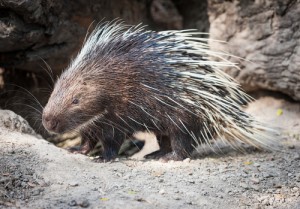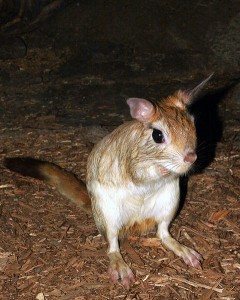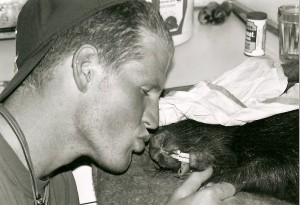In 2001, fresh out of college and yearning for adventure, I moved to South Africa. My recollection is that I had seen Cry the Beloved Country and The Power of One several times and decided that I had to go to Africa to intern at the University of Cape Town and write bad poetry. I’ll admit, the entomology professor I called to inform that I would be volunteering in his lab was a bit confused but when I told him that I wouldn’t cost him a cent (or a rand, in this case), he said fine.
It was during this odd sort of internship that I signed up for my great porcupine adventure. It seems that occasionally documentary films draw from grad schools for cheap labor tracking and tagging animals that they will be following for a show (if you truly love nature documentaries and believe they are all spontaneous, stop reading now before I shatter your illusions). Many documentaries send able and moronic young people into the bush months beforehand to implant tracking devices into animals to make them easy to follow and habituate.
I’ll get to “habituate” in a second, but first we had to catch the little bastards. I was hired by a company doing a BBC documentary on aardvarks and the animals that live in their burrows (thrilling, right?). Our focus would be the porcupine.
The African porcupine, as you doubtless know, is a fearsome creature that haunts the nightmares of all Africans and turns even the bravest warrior’s knees to jelly. 
Actually, no. Thanks to their somewhat impenetrable defense system, porcupines have become somewhat languid in their self-defense philosophy. If confronted by a foe, they shrug their little shoulders, put their head against the nearest tree, and raise their spines as if to say, “look, we all know how this will end, do yourself a favor and piss off.”

But they are hard to find and night after night, from 10PM to 3AM we would drive a comically large truck through the bush waving giant flashlights to and fro. My companions were a recalcitrant biologist and a former drug dealer using the time to get over his heroin addiction. When weren’t searching for porcupines, we were playing a favorite bush game “catch random animals barehanded.” My target was always the spring hare, an adorable rodent I learn has two speeds: “really fast” and “ultra sonic.” Needless to say, I chased many but never caught one.
We did find multiple aardvark holes, though. It was ironic that the prep crew for a documentary on aardvark holes sunk their truck into so many. Imagine a tunnel big enough for a child to crawl through. Now imagine a truck so buried in that tunnel that the bumper is almost on the ground and you can imagine one of our fun-filled nights.
We did eventually catch a porcupine (after finally buying gloves on the fourth day) and dubbed him “Uncle Erik.” We loved Uncle Erik, but I doubt he felt the same since his first experience with us was to be shot up with ketamine and have a radio tracker surgically implanted into his belly. Then the cruelest part of the entire process began – habituation. Habituation is a little like domestication except you do not feed the animal. You just hang out around it until it loses its fear of you – you are neither predator nor food-giver – and ignores you. Each night I would track down Uncle Erik and follow him around and just talk to him.
This brings up a number of questions, but the biggest was, “what do you say to a porcupine?” I tried singing for a while, but that was weird. So I decided to discuss my relationship.
“… So then she said it was my fault and that she never even wanted to go in the first place. Which was crap, because she said that we need to spend more time together, and I told her that I don’t have time to hang out every weekend …”
Meanwhile the porcupine sits silently with his head against a shrub, spines up, thinking, “for God’s sake. Shut. The. Hell. Up.”
“… but I like my apartment and don’t feel ready to move in together. I’m a free spirit, you know? So I told her …”
“Jesus Porcupine Christ, just kill me now.”

“… and what does ‘exclusive’ even mean? It’s not like I can’t have friends of the opposite …”
One night, in the midst of this drivel, I heard thunder and walked up to see if a storm was coming. It was a ways off, so I turned back to Uncle Erik, who had gone. Switching on my receiver, I realized that he was not even within the 50 yards needed to track him. Essentially, first chance he got he had just sprinted away, without looking back. Those who know porcupines know that sprinting is a rare thing for them.
And so it went, night after night, until Uncle Erik just ignored us and went about his business. After two weeks in the bush, it was time to go back to Cape Town and my life of cataloging isopods and collecting ants. I often think about those nights, alone with Uncle Erik. Certainly, there are ethical questions about the treatment of porcupines (who, I should say, are not endangered) for entertainment purposes. Certainly, we were unqualified to be running around the African desert snatching rodents. But for a young man, eager to take on the world, chasing spring hares and following porcupines seemed the grandest of all adventures.
Photos courtesy of Shutterstock, Devonpike, and myself.

A Hell of a good read, and very, very funny. Lovely piece. Oh, and informative about the slightly dubious behaviour of animal documentary makers, too. Not, I suspect, that that was the point.
Of course not. Any understanding you gleaned or implication you thought you heard that I felt that nature documentaries are anything but the height of ethical responsibility is completely fallacious, I assure you. Silly of you to even suggest it (that goes double for any BBC lawyers who might be reading).
A fine read Erik. I like your sense of humour but it will take more than good writing to convince me that porcupines are not passive pests. Keep dogs and axe handles away from porcupines. No good comes from such associations.